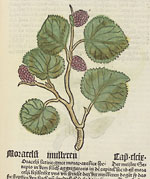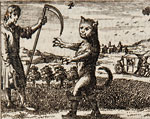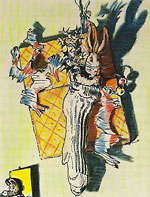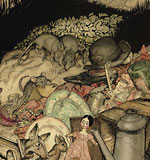From Incunabula to Modern Firsts—What’s Cooking at Auction
The Garden of Health
Gart der Gesundheit, £169,250 ($255,737) at Christie’s London on July 7.
A landmark in botanical studies and natural history illustration, Gart der Gesundheit marked a complete break with medieval traditions of crude, generic representation and offered instead accurate depictions of the plants being discussed, although the spread reproduced here does continue the myth of the Mandragore or Mandrake (white bryony), which is supposed to scream when pulled out of the ground.
The work was planned by Bernard Breydenbach before he set off on a pilgrimage to the Holy Land that resulted in another bibliographical first—the first illustrated travel book, Peregrinatio in terram sanctam, of 1486. He commissioned Johann Wonnecke von Cube to describe the plants and their medicinal uses and Erhard Reuwich, the artist who accompanied Breydenbach to the Holy Land, was instructed to sketch plants as they traveled though the Mediterranean.
Of the 379 mostly botanical woodcuts, around 90 can be attributed to Reuwich, but others derive from the Codex Berleberg, a manuscript owned by Breydenbach. Printed in Mainz in 1485 by Gutenberg’s successor, Peter Schöffer, this first edition copy from the Arcana Collection is colored throughout in a contemporary hand and is in a sixteenth-century German binding by Georg Freyberger.
In 1980 it sold for $79,200 in a Sotheby’s New York sale of books from the library of the Massachusetts Horticultural Society. It was acquired at the time by Robert de Belder, but it was not part of the 1987 Sotheby’s London sale of his great library, having previously been sold on to London dealers, Quaritch.
Perhaps inspired by the £276,150 (then $428,030) paid for another fully colored copy at Sotheby’s London in 2002, Christie’s had hoped that it might make $300,000 or more, but this market is not as strong as it once was.
Fairy Tale Beginnings
Charles Perrault, Histoire ou Contes du Temps Passé, £61,000 ($88,375) at Bloomsbury Auctions in London on May 27.
This was the work that introduced the now familiar versions of such popular fairy tales as Little Red Riding Hood, Cinderella, and Puss in Boots, who is seen in the page reproduced here. This is not however, the true first edition of 1697, printed by Claude Barbin of Paris, but an unauthorised printing bearing the Amsterdam imprint of Jacques Desbordes that appeared in the same year, its pictorial title and headpieces copied from the original engravings by Antoine Clouzier and printed in reverse.
Both the Barbin and Desbordes editions are now very rare and only seven copies in all appear in auction records of recent decades, but leading all of them in price terms, however, is the Barbin edition in a nineteenth-century morocco extra-gilt binding by Trautz-Bauzonnet that made 2.16 million francs ($283,835) at Sotheby’s Paris in 2001.
How Toys Become Real
Arthur Rackham, “Jensina and the Rubbish Heap,” $37,500 at Christie’s New York on June 22, and Margery Williams Bianco, The Velveteen Rabbit, £8,540 ($12,375) at Bloomsbury Auctions of London on May 27.
From Pinocchio to Woody and Buzz Lightyear, the notion of toys coming to life has been a popular narrative with children’s authors and filmmakers, and Margery Williams Bianco was fortunate in the illustrators that some of her books attracted. “Jensina and the Rubbish Heap” is one of illustrations that Rackham made for Poor Cecco, which relates the adventures of a wooden dog with humans, animals, and other toys such as Jensina, an independent minded and spirited wooden doll. Signed and dated 1925, this ink and watercolor drawing is also inscribed on the back to indicate its use in the third installment of the original serial publication in the magazine Good Housekeeping.
An earlier Bianco story, The Velveteen Rabbit, or How Toys Become Real, was famously illustrated by the artist William Nicholson, and the 1922 first sold in London was an excellent copy bearing, among others, the bookplate of the leading British typographer Ruari McLean, that Bloomsbury had hoped might sell for as much as $15,000.








 Ian McKay’s weekly column in Antiques Trade Gazette has been running for more than 30 years.
Ian McKay’s weekly column in Antiques Trade Gazette has been running for more than 30 years.


